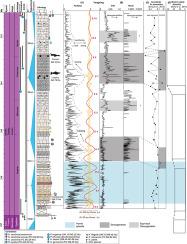Palaeogeography, Palaeoclimatology, Palaeoecology ( IF 3 ) Pub Date : 2021-03-09 , DOI: 10.1016/j.palaeo.2021.110355 Dongyang Liu , Chunju Huang , James G. Ogg , David B. Kemp , Mingsong Li , Meiyi Yu , William J. Foster

|
The timing and pattern of ecosystem recovery following the end-Permian mass extinction are still highly controversial, and a potential influence from orbital climate forcing is often not considered. To investigate this issue, a cyclostratigraphic analysis of an Anisian (Middle Triassic) marine platform succession (Guanling Formation, Yongning section, South China) using elemental proxies and lithofacies has been carried out. Spectral analysis of proxies for terrestrial flux (Fe/Al and Zr/Al) indicate significant cycles. Based on available age constraints and sedimentation rate modelling, the recognized cycles include 405-kyr long eccentricity, 100-kyr short eccentricity and ~ 20-kyr precession cycles. Anchoring these signals to a dated and widespread “green bean” volcanic ash layer (246.6 Ma) and tuning to stable 405-kyr long-eccentricity cycles yields an astronomical time scale spanning ~4.2 + 0.3/−1.4 Myr (246.7 to 242.5 + 0.3/−1.4 Ma) in the Anisian. This time scale constrains the ages of the Luoping biota (which marks the earliest complex Mesozoic marine ecosystem in South China) and the Panxian marine vertebrate biota to 243.8 + 0.3/−1.4 and 243.4 + 0.3/−1.4 Ma, respectively. The early Anisian is characterized by intercalated claystone and marls with high values in terrestrial flux proxies, indicating an intensified hydrological cycle due to a humid climate in the study area. This was followed by a long-term cooling trend into the late Anisian, as indicated by declining terrestrial flux proxy values. Seawater redox conditions were assessed using V/Al, Mo/Al and lithofacies analyses, and these data reveal possibly two putative deoxygenation events during the Anisian. Our new high-resolution redox data can also be correlated with results on Anisian ocean redox changes elsewhere. Our new astronomical timescale and high-resolution geochemical data provide key constraints on the timing of marine ecosystem recovery after the end-Permian mass extinction. Orbital forcing seems to have played an important role in modulating chemical weathering and seawater chemistry dynamics that impacted the timing of ecosystem recovery.
中文翻译:

Anisian(中三叠纪)期间化学天候和氧化还原的天文学强迫变化:二叠纪末次生物大灭绝对海洋生态系统恢复的影响
二叠纪末大灭绝后的生态系统恢复的时间和方式仍存在很大争议,并且通常不考虑轨道气候强迫的潜在影响。为了研究这个问题,已经使用元素代理和岩相对阿尼西斯(中三叠世)海洋平台演替(华南永宁段宽岭组)进行了地层分析。地磁通量(Fe / Al和Zr / Al)的代理光谱分析表明存在明显的周期。根据可用的年龄限制和沉积速率模拟,公认的周期包括405 kyr长的偏心率,100 kyr短的偏心率和〜20 kyr的岁差周期。将这些信号锚定到过时且广泛使用的“绿豆”火山灰层上(246。6 Ma)并调整到稳定的405 kyr长偏心率周期会在Anisian中产生一个天文时间标度,跨度约为〜4.2 + 0.3 / -1.4 Myr(246.7至242.5 + 0.3 / -1.4 Ma)。这个时间尺度将罗平生物群(标志着华南最早的复杂中生代海洋生态系统)和盘县海洋脊椎动物生物群的年龄分别限制为243.8 + 0.3 / -1.4和243.4 + 0.3 / -1.4 Ma。早期的阿尼西亚人为特征,其间插有粘土岩和泥灰岩,它们在地面通量代理中具有很高的价值,这表明由于研究区域的潮湿气候,水文循环加剧了。随后,进入陆面的Anisian出现了长期的降温趋势,这是由地面通量代理值的下降所表明的。使用V / Al,Mo / Al和岩相分析评估了海水的氧化还原条件,这些数据可能揭示了Anisian期间的两个假定的脱氧事件。我们新的高分辨率氧化还原数据也可以与其他地方的Anisian海洋氧化还原变化的结果相关联。我们新的天文时标和高分辨率地球化学数据为二叠纪末大灭绝后海洋生态系统恢复的时间提供了主要限制。轨道强迫似乎在调节化学风化作用和海水化学动力学方面起着重要作用,影响了生态系统恢复的时间。我们新的天文时标和高分辨率地球化学数据为二叠纪末大灭绝后海洋生态系统恢复的时间提供了主要限制。轨道强迫似乎在调节化学风化作用和海水化学动力学方面起着重要作用,影响了生态系统恢复的时间。我们新的天文时标和高分辨率地球化学数据为二叠纪末大灭绝后海洋生态系统恢复的时间提供了主要限制。轨道强迫似乎在调节化学风化作用和海水化学动力学方面起着重要作用,影响了生态系统恢复的时间。


























 京公网安备 11010802027423号
京公网安备 11010802027423号